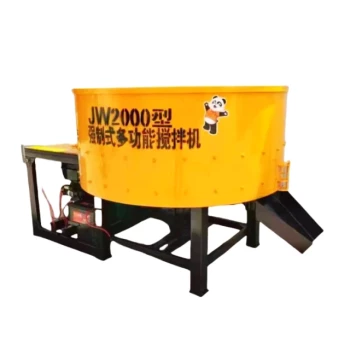Rotary Batch Mixers are designed to blend materials efficiently with minimal energy consumption. The requirement for a low-power motor stems from the mixer's operational dynamics—slow rotation speeds combined with high mixing efficiency reduce the need for high torque or rapid movement. This design not only conserves energy but also minimizes wear and tear, ensuring longevity and cost-effectiveness.
Key Points Explained:
-
Slow Rotation Speed
- The Rotary Batch Mixer operates at a deliberately slow rotational speed to ensure thorough blending without excessive mechanical stress.
- Lower speeds mean less kinetic energy is required, allowing a smaller, low-power motor to suffice.
- This also prevents material degradation, especially important for sensitive or fragile components.
-
High Mixing Efficiency
- The design of the (volumetric mixer)[/topic/volumetric-mixer] ensures that materials are mixed uniformly with minimal energy input.
- The tumbling action and internal baffles (if present) enhance mixing without relying on high-speed agitation.
- Efficient mixing reduces processing time, indirectly lowering power demands.
-
Energy and Cost Savings
- A low-power motor consumes less electricity, reducing operational costs.
- Lower power requirements also mean smaller, more affordable motor units can be used without sacrificing performance.
- Have you considered how energy-efficient designs like this contribute to sustainability in industrial processes?
-
Reduced Mechanical Wear
- Slower operation decreases friction and heat generation, prolonging the lifespan of both the motor and mixer components.
- Less maintenance is required, further cutting long-term expenses.
-
Material-Specific Advantages
- For delicate or abrasive materials, high-speed mixing can cause damage or excessive wear.
- A low-power motor ensures gentle handling, preserving material integrity.
By optimizing power usage while maintaining performance, Rotary Batch Mixers exemplify how thoughtful engineering can balance efficiency, durability, and cost—qualities that quietly shape modern manufacturing and processing industries.
Summary Table:
| Key Benefit | Explanation |
|---|---|
| Slow Rotation Speed | Ensures thorough blending with minimal stress, reducing energy needs. |
| High Mixing Efficiency | Uniform mixing via tumbling action, eliminating high-speed agitation. |
| Energy & Cost Savings | Lower electricity consumption and affordable motor options. |
| Reduced Mechanical Wear | Slower operation decreases friction, extending equipment lifespan. |
| Material-Specific Safety | Gentle handling preserves delicate or abrasive materials. |
Upgrade your blending process with GARLWAY’s energy-efficient Rotary Batch Mixers! Designed for construction and industrial applications, our mixers deliver unmatched durability and cost savings. Contact our team today to explore tailored solutions for your project needs.
Related Products
- Ready Mixer Machine for Construction Ready Mix Machinery
- Harbor Freight JS1500 On Site Concrete Mixing Volumetric Cement Mixer
- HZS90 Large Multiquip Concrete Mixers for Construction
- Shaft Mixer Machine for Cement and Regular Concrete Mixing
- Commercial Construction Mixer Machine for Soil Cement Mixing Concrete
People Also Ask
- Are there different types of concrete mix? Explore Varieties for Optimal Construction
- How does concrete not harden in a truck? The Science Behind Workable Concrete
- Can a concrete mixer be used for mortar? Key Considerations for Optimal Mixing
- What are the benefits of concrete mixer machine? Boost Efficiency & Quality in Construction
- How do you maintain a concrete mixer? Essential Tips for Longevity & Performance



















